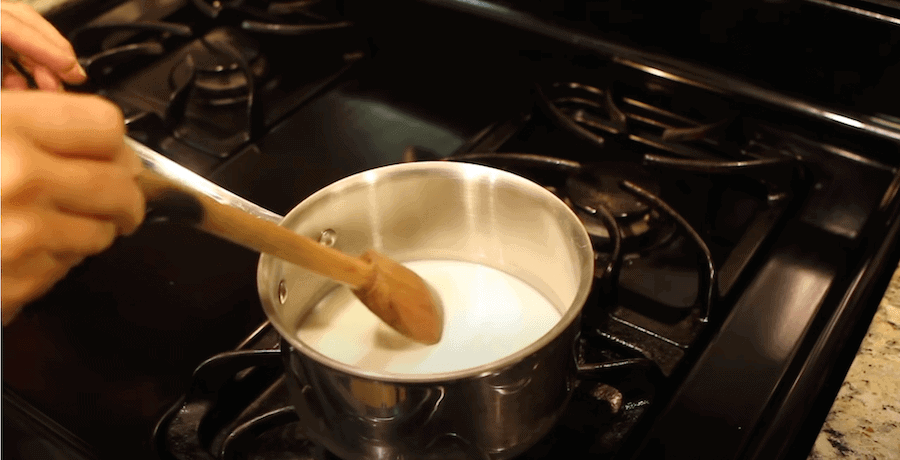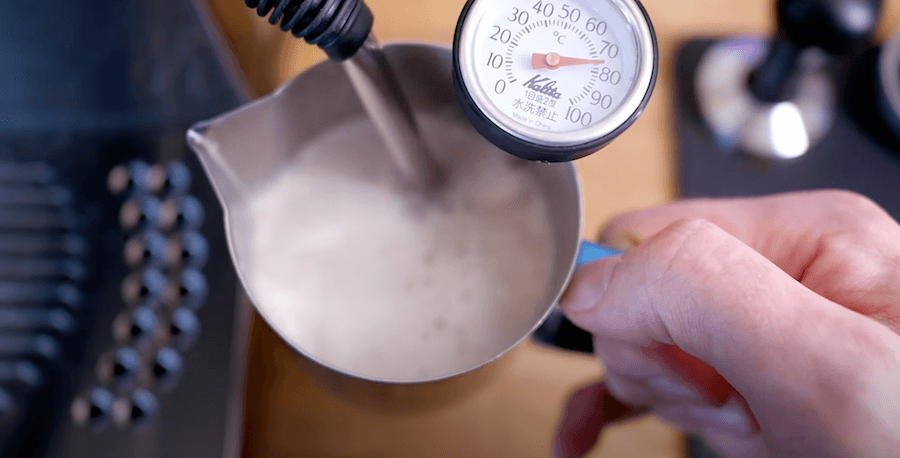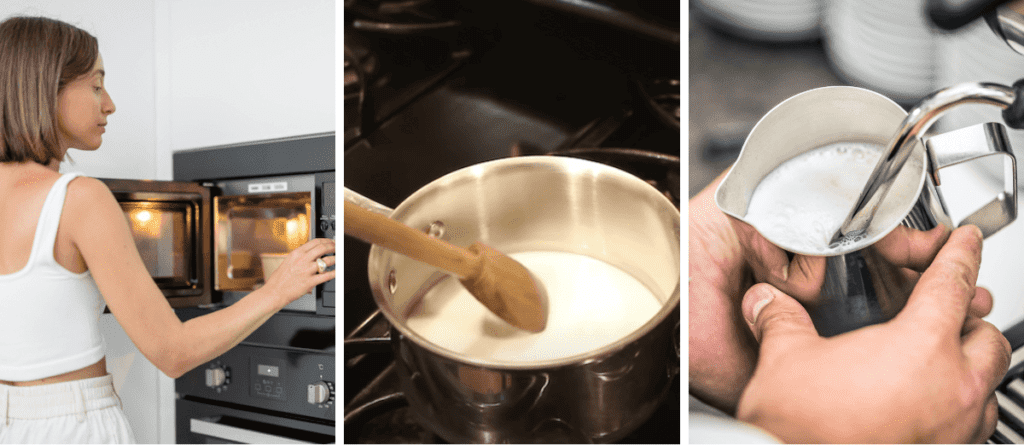Heating oat milk is easy and a great alternative to dairy and nut milk. You may be looking to warm oat milk for your coffee or cappuccino, to use in a baking recipe, or even to drink before bed! In all these scenarios, the secret is to keep the oat milk from boiling. Once it boils, the texture and taste are less desirable.
Here are the most popular ways to heat oat milk, plus a few tips so you can enjoy it at its best!
How To Heat Oat Milk In The Microwave
Heating oat milk in the microwave is fast and easy. You don’t need any fancy equipment, and it works every time! The only thing you need to watch out for is overheating. If oat milk overheats or boils, it can end up slimy, and the taste can change. It will also start to thicken and may separate or curdle.
Microwave Instructions:
- Put the desired amount of oat milk into a glass or microwave-safe container.
- Start heating the oat milk in 15-second intervals on medium heat.
- Stir the oat milk every time the microwave stops, ensuring that the oat milk heats evenly.
- The oat milk should be steaming but not boiling. If it’s boiling, you’ve gone too far.
It should only take about 30 seconds to 1 minute to heat your oat milk, depending on the temperature you start at and the amount of oat milk you are heating.
The biggest downside to heating your oat milk in the microwave is that it’s easy to overheat. Just make sure you don’t get lazy and skip the step of stopping and stirring the oat milk every 15 seconds! Doing this will also keep you from making a mess in the microwave.
Is It OK To Microwave Oat Milk?
Yes! It is perfectly fine to microwave oat milk. Just be sure to check it every 15 seconds and give it a stir to keep it from overheating.

How To Heat Oat Milk On The Stove
Heating oat milk on the stove is easier than using the microwave because you can keep an eye on it to prevent it from overheating and stir it more frequently.
Stove Instructions:
- Put the desired amount of oat milk into a small pot and set the heat to medium-low.
- Stir the oat milk periodically for even heating.
- It is ready when the liquid starts to steam or you see little bubbles on the sides. You want to remove the oat milk from the heat before it starts to boil to keep it from overheating, which will change the consistency and taste.
If you have a cooking thermometer, remove the oat milk from the stove as soon as it reaches 150°F for the best results.

How To Heat Oat Milk With A Steamer
Steaming oat milk is very similar to steaming cow’s milk. In the past, baristas avoided steaming plant-based milk because they didn’t steam as well as dairy milk. However, new, barista edition oat milk has become immensely popular because they not only steam well but are also dairy and nut free!
Steaming Instructions:
- Introduce air to the oat milk by placing the steam wand tip just under the surface for a few seconds. This will aerate the milk and create the foam desired for lattes or cappuccinos.
- Then, submerge the wand a few inches under the surface of the milk. This distributes the air evenly throughout the milk and reduces the surface bubbles, creating the perfect microfoam!
- Once the oat milk is hot, remove the pitcher from the wand and tap the pitcher to remove any extra bubbles.
- Give the milk a swirl to even out the consistency.
- Your oat milk is now steamed and ready to pour!
Slimy Oat Milk
Why Oat Milk Gets Slimy When Heated
When oat milk is exposed to high temperatures, it goes through a chemical change and can separate. You may notice that different brands of oat milk react differently when heated. This is because some brands add oils and stabilizers (like canola oil/rapeseed oil) to manipulate the taste and consistency of the beverage. Specially formulated oat milk lines called ‘Barista Editions’ have extra fats and oils added so that the oat milk reacts to heat more like cow’s milk than pure oat milk does.
How To Keep Oat Milk From Getting Slimy
Overheating oat milk can cause it to thicken, get slimy, and curdle. Ideally, you would only warm oat milk up to 150°F (160°F max). Heating it past this will change the consistency and taste.
Tips For Coffee:
- Pour the oat milk into your mug first, then slowly pour in your coffee. This will slowly introduce the oat milk temperature to the coffee temperature and prevent unwanted curdling.
- If your oat milk keeps separating in your coffee, despite being careful with the temperature changes, try a low-acid coffee. If your coffee is very acidic, the oat milk may react with it regardless of the temperature.
- (Check out our list of the best oat milk in coffee here!)
Tips For Baking:
- If your cooking or baking recipe calls for warm oat milk, heat your oat milk starting from room temperature instead of cold (right out of the refrigerator). Let the oat milk sit out for a little to get rid of the chill before gently heating the oat milk in the microwave or on the stove.
Things To Know About Heating Oat Milk
Can You Boil Oat Milk?
Technically, yes, it will boil, but in most cases, you don’t want it to. Once oat milk starts to boil, it can thicken and take on a different texture. This may work for cooking or making a sauce, but it’s not ideal for drinking. Slowly heat oat milk in 15-second increments and stop when you see steam to keep it from boiling.
Can You Reheat Oat Milk?
Constant reheating can affect the texture and flavor of your oat milk. Additionally, if it has been warmed and touched (someone drank from it), bacteria from their mouth can get into the liquid and start to grow if its not kept at a hot temperature. It is best to avoid reheating, but if it is untouched, it can be returned to the fridge if it hasn’t reached room temperature yet.

Heating oat milk is easy and there are a few different ways to do it. We’ve outlined the steps for heating oat milk in the microwave, on the stovetop, and with a steamer. Remember that you don’t want to overheat your oat milk or it will become thick and slimy!
Recent Posts
Oat Milk Latte (Calories, How To Make At Home, & More Oat Coffee Drinks!)
Are you seeking a creamy, delicious dairy-free coffee drink that won't break your calorie bank? Look no further than the oat milk latte! Oat milk is becoming increasingly popular among...


